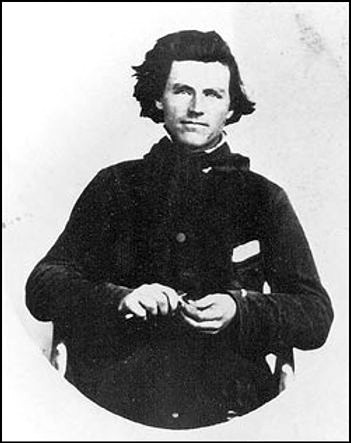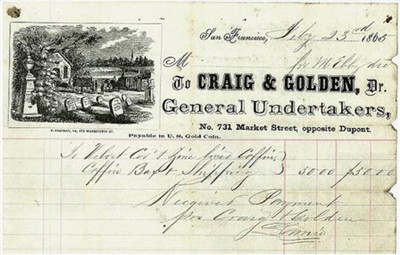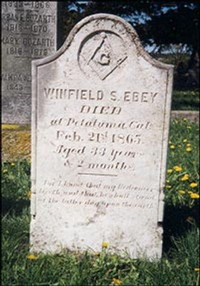The History of Sunnyside Cemetery
1865


Courtesy of Island County
Historical Society
On March 16, 1865, a steamer docked at Port Townsend and discharged a coffin containing the remains of Winfield Scott Ebey. Winfield, a consummate diarist, had lived on Whidbey Island since 1854, dutifully chronicling daily life and creating an unparalleled record of its history. But by 1863 he was sick in body and soul. Plagued by tuberculosis, he acutely felt the loss of his beloved brother, Isaac, his parents, sister Ruth, and niece Hetty. In September 1864, he sailed for California in hopes of finding a cure for his affliction, but it was too late. On January 20, 1865, he wrote a final letter to his sister, Mary Ebey Bozarth, telling her, "I should like to live longer but death must come upon us sooner or later + I have found but little in this world worth living for." He died a month later at age thirty-three and his body was shipped back to Washington, arriving before his final letter reached home. Unaware of how ill he had become, Mary Bozarth learned the shocking news of his death when she received word from Port Townsend to come claim his body. Her decision about where to bury Winfield would shape today 's Sunnyside Cemetery.

Courtesy of Washington State Archives
As the sole surviving member of her parents ' family, a shaken Mary Bozarth saw the Ebey 's presence on Whidbey greatly diminished following the death of her brother, Winfield. She was uncertain if Isaac 's sons, Eason and Ellison, would retain ownership of their parent 's claim on Ebey 's Prairie—and consequently the original Ebey burying ground. As for herself, she had inherited half of Sunnyside Farm following her brother 's death, with Isaac 's sons jointly inheriting the remainder. Her parents, Jacob and Sarah Ebey, had chosen the land soon after they arrived on Whidbey and there they began building their new home in October 1855. The property adjoined the western border of Isaac 's property and overlooked his farm, Admiralty Inlet, and the Cascade Range from Mount Baker to Rainier. Winfield, himself, had christened it, as he noted in his diary on February 27, 1856: "Father + Mother moved to their new house on the hill or "Sunnyside" as I sometimes call it. Moved up + I am spending my first night at the new place."

Sunnyside Cemetery
Photo by Theresa Trebon
In contemplating where to bury Winfield, Mary decided to buy out her nephews ' interest in Sunnyside, take sole control of farm, and safeguard her family 's final resting place by creating a new graveyard under her control. In April 1865 Mary wrote her son, Polk, in California, stating, "...my heart is verry [sic] sore and indeed my troubles great when I think that I am the last of my family ... I did not hear that your uncle was dead until his remains was brought to Port Townsend ... I had him buried on the hill on the point of the claim ... I intend having the others brought there this spring ... As half the land will be mine I think of trying to buy the other half if the boys don 't ask too much for it. I am verry anxious to live there and at last be buried with my parents and brothers and sisters." And so Mary moved into her parents home at Sunnyside, a place that soon became known as Bozarth 's Hill. And on March 19, 1865, she laid her brother, Winfield, to rest on their parent 's farm, the first burial in the "Ebey Grave Yard on the hill."

